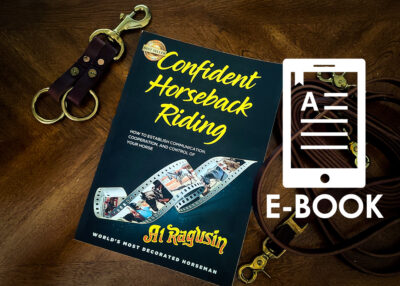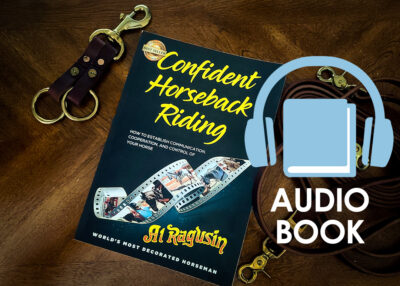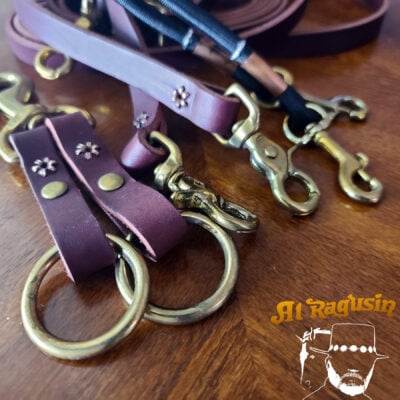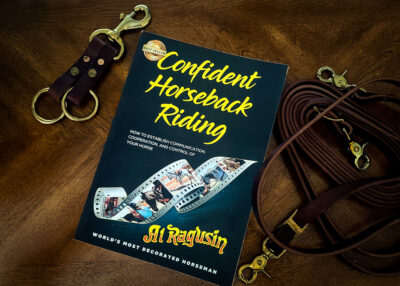Train my own horse
I have trouble keeping him under control most of the time and this scares me replies Sarah Andis. I have been advised to send him to a trainer. I answered her this way, providing the trainer can really train him and how then only the horse gets trained.
No, Sarah you must train him yourself. I will show you the method both with communicating with him and my technique on how to do that. I know you are probably thinking here we go again, another method and buying more equipment and it may work or again it may not. Then I would be back to square one where I am at right now.
She just gave me a smile.
Table of Contents
How to make your own equipment for under $20.00
I asked her have you ever loped or cantered with your horse? Yes, she says, then I said to her it would take two lessons. The first one is to adjust your horse to my reins and then the second lesson would be for you to show him my technique that I will be showing you as you are riding him. It shouldn’t take more than four hours maximum. Yes, Sarah you would have to use my equipment but no you would not have to buy it. You can make your own for under $20.00. I have two types of reins the one that I just mentioned is made out of 3/8” nylon rope, 1 1/2“ rings and some trigger snaps. The other newer reins comes with rollers and they are made of leather. Both do the same job.
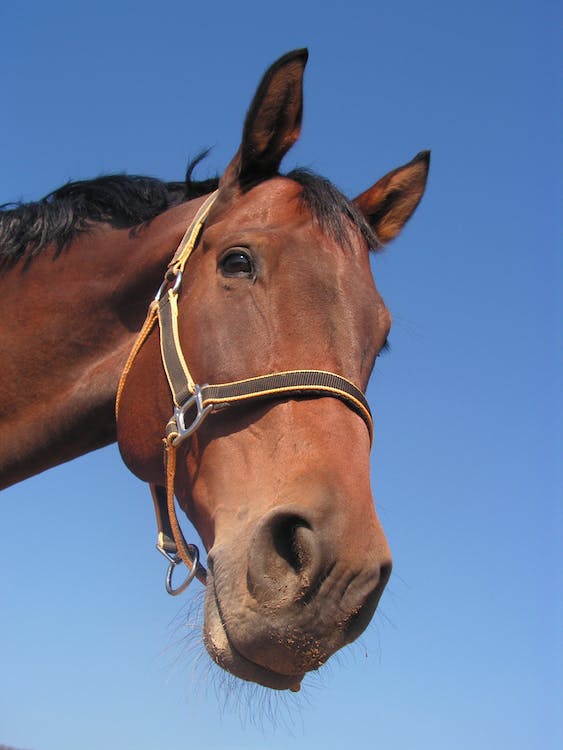
Or if you want you can order some already made along with a DVD showing you how to adjust them. I need for you to come with an open mind and really forget all that you have heard and read until I am finished with these two lessons. This method will work for you in any discipline that you choose. (train my own horse)
This is my 49th year of training horses. Over 25 years ago I stopped training horses for people simply because I was not helping them by training their horses. In fact, I was making it worse because the horses were trained to react to my cues and the horse owners did not know what those cues which compounded the problem. No folks, you must learn to Train Your Own Horse, there is no other way.
The simple and fast method of training your own horse
I will show you the method. It is simple and easy to understand and will not hurt your horse in any way. I will make him as comfortable under saddle as possible and I will use a bit that does not pinch or hurt him. Well it took Sarah and her gelding about three hours total and she had it down pat. I talked to her a couple of weeks ago and asked how she was doing. She replied, he is like a different horse. Once in awhile I find my hands out of position and this is the time that he will try to take control but just move my hands back into position and he immediately collects himself.
I have trained hundreds of folks to train their own horses and possibly thousands on television and through my articles and clinics. Training a horse is really not as difficult or as magical as some trainers would like everyone to believe. The horse is a very simple animal and he lives in a horse world. (train my own horse)
He was born with herd instincts which one of you will be in control. If you don’t take the lead he will. He will harbor no resentment, it is not like some argument or disagreement that you would have with some other person. Let me give you an example.
Let’s say you and your friend had a difference of opinion and one has to compromise so the one doing the compromising may hold some resentment for compromising then he would be quick to tell you I told you so if his way proved to be the right way. It is not the same with the horse. He may want to go one way and through your hand position and leg cues you tell him you want to go another way.
His simple reaction will be “OK” because to resist the equipment would make it uncomfortable to do it his way, and he is not going to want the added discomfort. The double rein attaches to his bit at four different points. While collecting him he is not uncomfortable, it is only when he wants to resist will it become uncomfortable.
There is no special way to hold the collection reins, you just hold them as one. The properly adjusted reins will do all the work. There will be no “giving to the hind quarters, giving to the front quarters, my space and his space, his mood or my mood, his natural way, or to get inside the horses head”, it will not be any of that stuff.
This method is so simple that is why it works so fast. Two weeks ago I gave a clinic in Atkins, Texas near San Antonio. I first performed my dancing horses and as I sang my horses dance to the rhythms of country, rock, including the “moonwalk”, rock-a-billy, cumbias, mambo, and other rhythms. Afterwards I did a one hour clinic and explained my technique.
My collection reins and how they help me get the dance movements. During this clinic I met a woman and her horse I had never seen or worked with her before. However since my time was limited my good friend Larry Rodriguez from Lavernia, Texas had introduced her horse to the elastic rein that comes with the two leather reins for about 15 to 20 minutes the week before my clinic. He did this so that the horse would be somewhat familiar with the elastic rein to conserve time during the clinic.
The lady had trouble in two areas, first she could not collect him and second she could not stop him well. After some adjustments on her stirrups and adjustments on her hand and feet positions the collection reins was able to collect her horse, stop her horse on cue and she learned how to change leads. All of that in less than 30 minutes, it’s that simple. Ask anyone that was there June 30, 2007.
You can go to my web site and down load many different articles on different disciplines also there are videos of the dancing horses and a weekly training video. All of this is free. It has been my pleasure passing on this technique to folks so that they can enjoy and train their own horses in a safe and positive manner.
The two methods of reinforcement: positive and negative
Allow me to give you a brief explanation of how my technique works. Basically there are two methods. One is Positive Reinforcement and second is Negative Reinforcement. Positive reinforcement can be used when your working him on the ground and give him a treat after he has responded to your cue. (train my own horse)
This can work if the treat is given the moment he does what you want because he lives in the moment but if you are riding him this would be impossible. I was taught this way in the early 60’s. First ground work and then on his back. I feel now years later that if my intention is to ride him just train him from the saddle, it just saves lots of time if riding is what you desire.
I think it was Monty Foreman, a great horse trainer, that said, “training horses is equal parts tradition and ignorance.” Bingo to you Monty, that is exactly right. Then there is negative reinforcement, which I think I was the first to use that term publicly. Remember I said negative not brutal. (train my own horse)
You never want to hurt your horse, you would lose his respect and concentration because he would be afraid. The word reinforcement is described in the dictionary as to strengthen or support, or to make more forcible or effective.
This method was taught to me by a tiny bee. As I was observing a mare and her colt, the colt was trying to nurse but his mother was moving around because she was bothered by a bee and she would not stand still. The colt was very irritated because he wanted to eat. Then the bee started buzzing around the colt, this made him forget about eating he just wanted that bee to go away.
The key words to remember when communicating with your horse
It came to me that that was the answer, apply the negative in order to accomplish the positive. Apply a cue that at the time will not mean anything to him until it is associated with an irritating gesture. Let me give you an example. While in your saddle press your left calf against his rib cage, “the cue” and gently tap his right leg with your crop. Continue the leg pressure and the cue until he moves his foot. He is doing this to stop the irritating tap. As he moves his foot take the pressure off the leg and stop the tapping. Pet him and let him know you are pleased then do it again. Soon he will associate the leg pressure “cue” with the tap.
He will then move the leg as you apply pressure to his rib cage before you tap him again. He will associate your cue with the tapping and he will anticipate the tapping following the cue. There are two things all horses will give you and that is ANTICIPATE and ASSOCIATE.
Remember those two words because they are the key to communicating with him. Then add REPETITION and that is the beginning of communicating with him. If you will do this in a 42’ round pen, this is the size the circus has used for hundreds of years and there is a reason for it.
You can teach him everything that he needs to know which includes leads, transferring power to his hind legs where the power is naturally using his front legs to steer and balance, collection, side pass, spins and more. Then you can take him out and do whatever event you want. You would not get in a car and drive off if you did not know how to steer or stop so why would you get on a horse that could not do the same. (train my own horse)
I write extensively on this subject which can be found on my web site, trainingyourownhorse.com. You might want to give this method a try I am sure it will work for you. Bye for now.
Your Friend,
Al Ragusin
TLDR (train my own horse)
Sarah is having trouble keeping her horse under control and is scared. She has been advised to send the horse to a trainer, but the person she is talking to tells her that she should train the horse herself. They will show her a method for communicating with and training the horse, which can be done in just two lessons. (train my own horse)
The first lesson is to adjust the horse to the reins, and the second is for Sarah to learn the training technique while riding the horse. This should take no more than four hours. The equipment needed for the training can be made for under $20 and does not have to be bought, but can also be ordered along with a DVD.
The person training Sarah has been training horses for 49 years and has trained hundreds of people to train their own horses. They explain that training a horse is not as difficult or magical as some trainers make it out to be, and that the horse is a simple animal that lives in a horse world and has herd instincts, one of which is to be in control.
If the owner doesn’t take the lead, the horse will. The training method is simple, easy to understand, and will not hurt the horse.
Sarah successfully trained her horse and said that he is now like a different horse.
(train my own horse)

